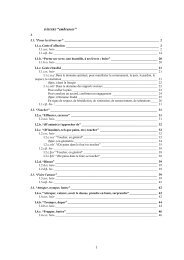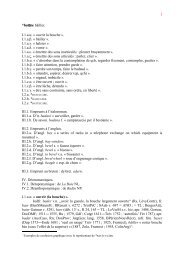barbus barbeau. I.1. barbus. Fr. bar m. « espèce de poisson d'eau ...
barbus barbeau. I.1. barbus. Fr. bar m. « espèce de poisson d'eau ...
barbus barbeau. I.1. barbus. Fr. bar m. « espèce de poisson d'eau ...
You also want an ePaper? Increase the reach of your titles
YUMPU automatically turns print PDFs into web optimized ePapers that Google loves.
5Locutions nominales : Argot <strong>bar</strong>billons <strong>de</strong> Varennes m. pl. <strong>«</strong> navets » (1628,SainéanSourc 1, 192) 10) , <strong>bar</strong>billons <strong>de</strong> Beauce/Bausse <strong>«</strong> navets, légumes » Mén 1694 ; kirsch<strong>de</strong> <strong>bar</strong>billon sg. <strong>«</strong> eau » (1870, EsnaultArg), anisette <strong>de</strong> <strong>bar</strong>billon f. Ds 1896.Sens secondaires : Argot <strong>bar</strong>billon m. <strong>«</strong> jeune souteneur » (1835, EsnaultArg = TLF;Lar 1867 ; Ds 1896) 11) . Avec apocope : Argot <strong>bar</strong>bill m. <strong>«</strong> souteneur, jeune en principe »(1841, EsnaultArg), <strong>bar</strong>bille Delv 1867 ; <strong>bar</strong>be (1885—SandryC 1957, EsnaultArg ; TLF s.v.<strong>bar</strong>be 1 ; ‘terme complètement oublié’ Breton). Avec resuffixation : Argot <strong>bar</strong>bise m.<strong>«</strong> souteneur, jeune en principe » (1884, EsnaultArg) ; <strong>bar</strong>biset (1885, EsnaultArg ; SainéanPar 264 ; RLiR 45, 259), d’où, par aphérèse, biset (1907, EsnaultArg) ; <strong>bar</strong>bizinque (1938,DoillonArg) ; <strong>bar</strong>bichon (1928, EsnaultArg). Par croisement : (× biquet <strong>«</strong> chevreau »)<strong>bar</strong>biquet <strong>«</strong> souteneur, jeune en principe » (1952, EsnaultArg ; Breton) ; (× bique <strong>«</strong> chèvre »)<strong>bar</strong>bique <strong>«</strong> souteneur » (2002, Perret, P., Le parler <strong>de</strong>s métiers ; Paris, 792b-793a), id. f.<strong>«</strong> homme viril <strong>de</strong> type western » (2007, Merle, P., Nouveau dictionnaire <strong>de</strong> la langue verte,Paris, s.v.) ; d’où, par conversion, <strong>bar</strong>biquer v. <strong>«</strong> jouer les <strong>bar</strong>biques, les <strong><strong>bar</strong>beau</strong>x » ibid.[+ -] LozèreNE. b a r b á s m. <strong>«</strong> goujon » CampAtlas 542 12) .[+ -ITTU] <strong>Fr</strong>m. <strong>bar</strong>bet m. <strong>«</strong> petit <strong><strong>bar</strong>beau</strong> » (1558—1867, Ron<strong>de</strong>let, G., Histoire entière <strong>de</strong>s<strong>poisson</strong>s ; Lyon, 140 ; Dictionnaire universel <strong>de</strong> sciences... ; Paris, 8 e éd., s.v. <strong><strong>bar</strong>beau</strong>; Cotgr1611), <strong>«</strong> <strong><strong>bar</strong>beau</strong> commun » (1909, TLF).[+ -] HSaône b a r b ü m. <strong>«</strong> <strong><strong>bar</strong>beau</strong>, Barbus <strong><strong>bar</strong>bus</strong> L. » (ALFC CXXXI p 55, 76),b rbü ibid. p 38, occit. <strong>bar</strong>but m. <strong>«</strong> <strong><strong>bar</strong>beau</strong>, <strong>poisson</strong> » M, PuyD. <strong>bar</strong>bu Reichel.Brun 2, 173 ; ALFC CXXXI ; ALLOr 458 ; ALLOc 360 ; CampAtlas 542 ; ALMC 384 ;ALAL 574.II. Emprunt.Afrb. <strong>bar</strong>be m. <strong>«</strong> <strong><strong>bar</strong>beau</strong> (<strong>poisson</strong>) » (1466, Gl 2, 248), gruy. b rbo, b rbo.Lt. BARBUS m. <strong>«</strong> <strong>espèce</strong> <strong>de</strong> <strong>poisson</strong> <strong>de</strong> la Moselle » (env. 370, ThesLL 1, 1748) estcontinué, outre en français, ci-<strong>de</strong>ssus (<strong>I.1.</strong>), par it. <strong>bar</strong>bo m. <strong>«</strong> pesce commestibile d’acquadolce <strong>de</strong>i Ciprinidi (Barbus <strong><strong>bar</strong>bus</strong> L.) » (dp. 1549, LEI 4, 1319), frioul. <strong>bar</strong>p, <strong>bar</strong>b, <strong>bar</strong> (toustrois DESF), cat. <strong>bar</strong>b (dp. 1262, DiccEtCat 1, 631), esp. <strong>bar</strong>bo (dp. 15 e s., Corom 2 1, 506),10 Classé sous BARBA (FEW 1, 246b), en compagnie <strong>de</strong> SR. <strong>bar</strong>bot m. <strong>«</strong> rave » qui, lui, est à ranger sousBORVO-, cf. Gl 2, 248.11 Par dérivation synonymique <strong>de</strong> : maquereau <strong>«</strong> souteneur » (dp. Ruteb, FEW 16, 502b, MAKELARE), <strong>poisson</strong>d’avril (Mich 1466―Trév 1771, FEW 8, 584a, PISCIS), <strong>poisson</strong> (dp. 1827, ibid.), etc. Il n’est pas nécessaire,comme le proposent CellardR 2 , d’en faire <strong>de</strong>s dérivés <strong>de</strong> fr. <strong>bar</strong>be dénommant un ‘jeune voyou dont la <strong>bar</strong>becommence seulement à pousser’, <strong>bar</strong>billon impliquant <strong>de</strong> soi-même la jeunesse et étant certainement à l’origined’argot goujon m. <strong>«</strong> jeune souteneur » (Rig 1878―Vill 1912), toujours par dérivation synonymique.12 D’après CampGéogr 2, 696, serait à rattacher à <strong>bar</strong>btá <strong>«</strong> <strong>bar</strong>boter » par l’intermédiaire d’un croisement avec<strong>bar</strong>ba. Il est plus simple d’y voir un augmentatif tiré, par changement <strong>de</strong> suffixe, <strong>de</strong> Lozère b a r b l<strong>«</strong> goujon » CampAtlas 542.




